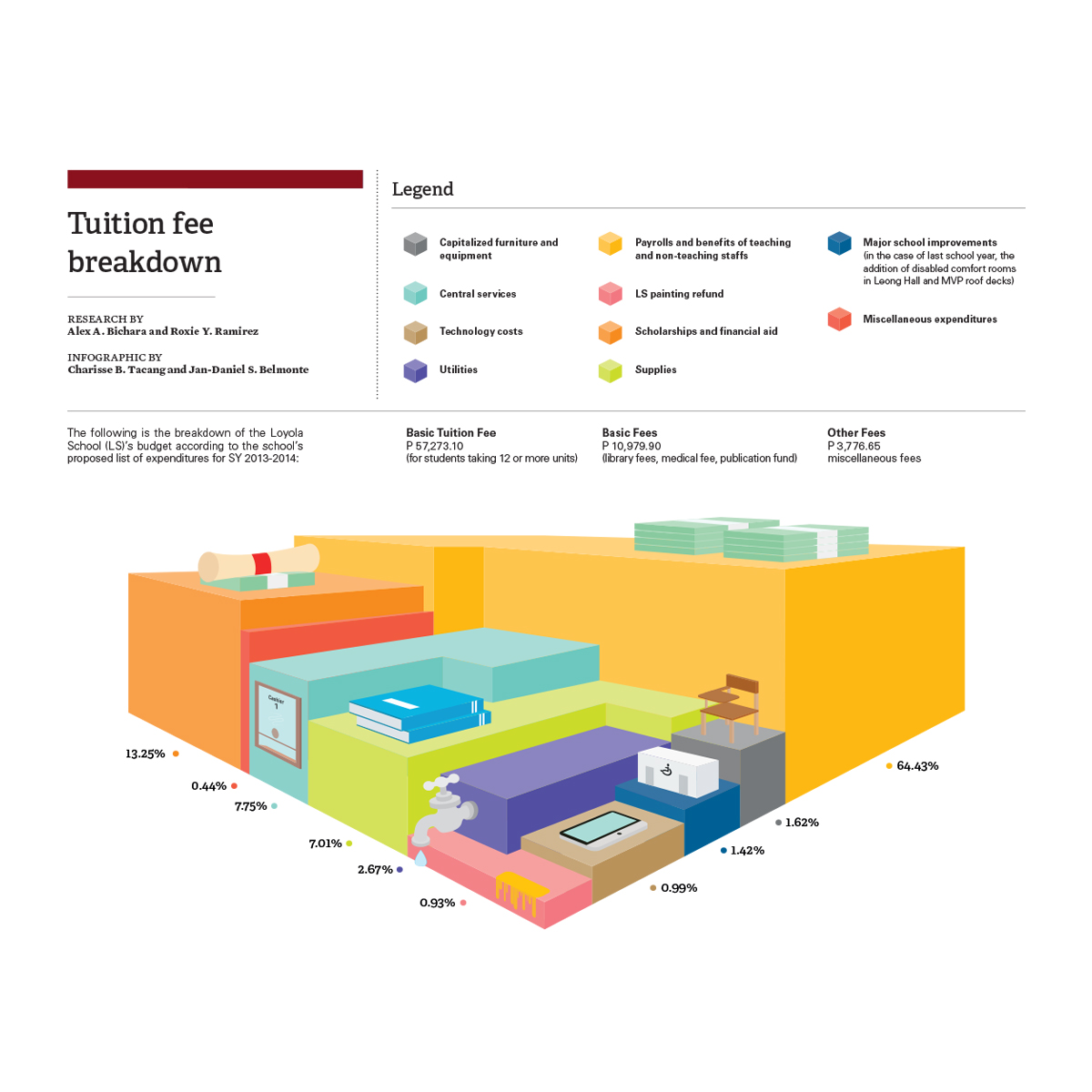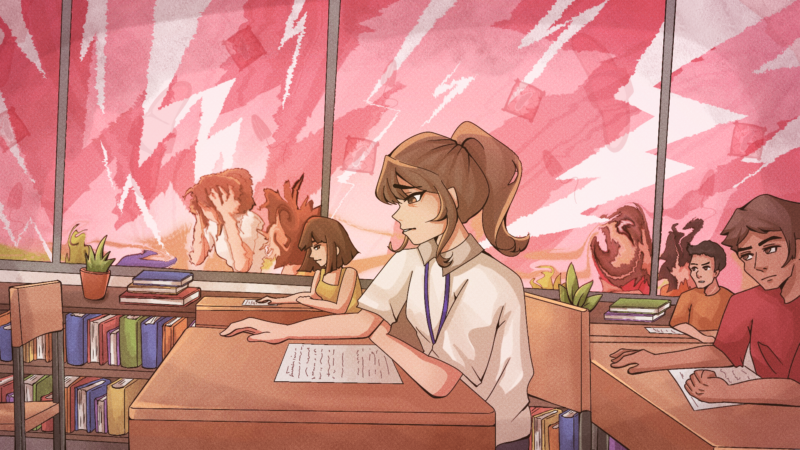Ongoing campus renovations and the recent expansion of the LS Bookstore are evidence that the Ateneo has devoted much of its budget to the improvement of its educational facilities. Despite this, students continue to question its annual 5% tuition fee increase and budget allocation.
Paying for higher education is a challenge faced by the majority of college students and their families, considering the steadily rising cost of tuition. This reflects the increase in the cost of all other goods and services, the rate of inflation and the diminishing purchasing power of the peso.
In the early 1980s, a four-door Mitsubishi Lancer cost P65,000 and a kilo of galunggong (roundscad) cost P6. In 1984, a 21 unit semester at the Ateneo cost about P4,700. Today, students with 12 units up to the maximum load per concentration have to pay the current tuition fee per semester (excluding other school fees) of P57,273.10.
The Ateneo is among the 72 NCR-based Higher Education Institutions that the Commission on Higher Education (CHED) allowed to increase tuition and other school fees for Academic Year 2013-2014. According to CHED’s list as of May 24, 2013, the Ateneo was allowed to increase its tuition fee by 5%, equivalent to P118.25. The university was also allowed to increase its “other school fees” by 5.13%, equivalent to P186.29.
In 1985 and 1991, the Ateneo’s tuition increase peaked at 20%. This may have partly been due to the change in the law on the regulation of tuition and other school fees.
Presidential Decree No. 451 imposed a ceiling of 15% on tuition fee increases. Batas Pambansa Blg. 232 (The Education Act of 1982) set forth the government’s policy of tuition fee deregulation by allowing private educational institutions to set their own tuition fee rates, subject to government approval.
The process
In a previous interview with The GUIDON, former LS Vice President John Paul Vergara explained that the Ateneo undergoes a yearlong process with regard to tuition.
It begins with the school’s offices and departments submitting their budget requests to the administration. The vice president then holds an annual forum called “Magtanong sa VP at sa mga Dekano (Ask the VP and the Deans),” which allows students to raise their concerns about tuition fees, major improvements and budgets. The Sanggunian and Loyola Schools Budget Committee (LSBC) student representatives regularly provide feedback to the LSBC to ensure student participation in the allocation of tuition funds.
This procedure determines how much money is to be spent the following year and which projects should be pursued for the upkeep of the university. Proposals are then processed by the LSBC and are consolidated by the end of the year. Roughly 64% of tuition revenue goes to employees’ salaries, while the rest is used for scholarships and financial aid, supplies, utilities, equipment and school improvements.
“The largest component of tuition is spent on salaries because the people who make up the Ateneo community is the single most important resource that the university has,” says Acting LS Vice President Rudy Ang.
Contrary to popular belief, revenue collected from enrollees is not the Ateneo’s only source of income. Ang explains that some government agencies, CHED and private foundations also fund research projects and provide scholarships.
According to Ang, “The university also has an endowment which we have raised over many years from donations of alumni and friends, and so the income from the endowment also supports university operations.”
Restricted and unrestricted
The school collects three basic fees from its students: Tuition, basic fees and miscellaneous fees. Their division can be found on the tuition assessment form.
Most of the fees that the Ateneo collects from tuition are restricted, explains Ang. Restricted fees include the publication fee and the student activities fee, the former used for student publications such as The GUIDON, Heights and Matanglawin, and the latter used to support the Office of Student Activities and the Council of Organizations of the Ateneo. Other examples include the Ateneo Schools Parents Council fee, which is used for projects of that council, and the comprehensive drug program fee, which can only be used for drug testing. Some of these restricted fees are found under miscellaneous fees while others are found under basic fees.
Ang emphasizes that these restricted fees can only be used for the projects that they are assigned to. “When restricted fees are collected, they are sent to an account where the money is accumulated,” he says. “We aren’t allowed to divert it to other purposes.”
So if, for example, a student publication does not publish any issues for a certain school year, the money collected for that publication is reallocated for the future. The current publication fee stands at P241.60, reduced from P345.20.
On the other hand, unrestricted fees include the LS Athletics Fee, which is used to support the school’s college athletic teams. Other examples are the LS Medical Fee, which goes to the medical services of the school and the Facilities Maintenance Fee, which goes to the upkeep of the school’s facilities.
Ang also explains that there isn’t a set budget for fees like the LS Library Fee and the Student Information System Fee. Rather, how these fees are budgeted is dependent on what those facilities need at the time. If a new air conditioning unit is needed for the Rizal Library, the money collected from the LS Library Fee is budgeted out accordingly.
The LS Library Fee, however, is used primarily for the upkeep of the library’s facilities and its acquisition of materials.
The Ateneo also takes into account student feedback and concerns when it comes to major improvements in the school. A covered walkway is to be built along SEC-A and Gonzaga this coming summer, responding to the call for more passable walkways during the rainy season. Similarly, the LS Bookstore was expanded due to complaints about the lack of space.
Rewarding merit
Because the high cost of tuition and its subsequent increase of 5% per year may hinder some students from enrolling in the Ateneo, the school takes steps to help out those who may not afford its tuition. According to the school’s list of expenditures for academic year 2013-2014, exactly 13.25% of the school’s tuition fee revenue goes to funding scholarships and financial aid for students.
In a 2012 article for The GUIDON entitled “New OAA director wants more aggressive recruitment,” Office of Admission and Aid (OAA) director Jumela Sarmiento, PhD, says that students should not count the Ateneo out from their list of potential universities just because of the high tuition costs.
The offers of the OAA are not exclusively for students who need financial assistance. It also offers scholarships like the Ateneo Freshman Merit and San Ignacio de Loyola scholarships, which are extended to graduating high school students who have shown academic excellence as well as outstanding leadership abilities. Those who are part of the Director’s List, or the top 200 entrance test passers, also receive a 25% scholarship.
Athletic scholarships are also available to students who are part of the school’s varsity teams, provided that they maintain a good academic standing.
Constant change
Rising tuition costs is common in the Ateneo, as are questions of where exactly those fees are going. The annual school budget is made known to the student population through the Vice President’s annual forum, and as Ang says, these are all public records.
Much like how the budget changes every year, so does tuition. With the current tuition fee increase pegged at 5% annually, students next year will have to pay more or less P60,136.76 in tuition fees alone. Similarly, the cost of the tuition fee will exceed P70,000 in five years or so.
But unlike the school’s budget, which can change drastically from year to year, tuition increases are a little more constant. In fact, it seems like the annual 5% hike in tuition is here to stay.







